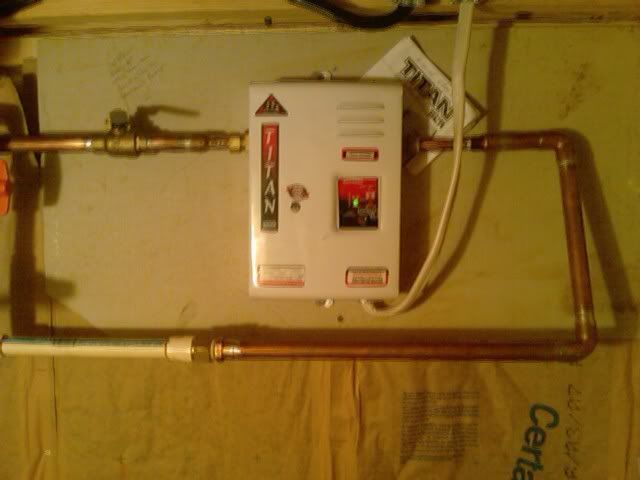I have installed 3 of these titan units and so far the customers have been happy with them. The electric ones have a problem when the incoming temperature is below 40 degrees running more then one fixture at a time.
I recently did a test when water was 38 degrees coming into at 80 psi: the best I could get this unit to perform running 2 fixture wide open was 98 degrees and 120 w/one. The way you can heat the water more efficient is to install a ball valve on the output side of the water heater and adjust it accordingly until you get the best temperature rise. If you do a little research you will notice that these electrics are recommend for warming climates.
Rated at 2 baths: I tested this with 2 fixtures running simultaneously and it handled it with no problem, it will do 3 but pressure falls This was in the summer time and water would do 120 plus degrees easily with 2 fixtures.
Electric requirements:
60 amp breaker
disconnect
6/2 w/g wire
Plumbing:
If your home has cpvc plumbing and not copper lines you must run 36" of 3/4" copper line on both the hot and cold side.
Cost:
$220 buys the unit
Pros:
Very cheap unit compare to competitors
Heats up very fast and hot(temperature adjustable up to 140 degrees)
10 year warranty
Cons:
I have noticed that on a 100amp service your lights will flicker when both stages of heating elements are on and your heating and cooling system(electric units) are running. 200 amp service you will be fine, if you are running more then one unit make sure you load calcs are in check.
I agree with the statements about the electric needs to be design around these thing, they draw a lot of amps and no one likes flickering lights. The rinnai gas units are some of the best in the market and if the house required a high demand of hot water this is your best bet. The gas units will heat the water in the exchangers until desire temp is reach, and you don't notice a huge fall out in temperature on long runs. Also the rinnai requires you to run 120v to the unit, it doesn't have a pilot light that stays on all the time which makes it more efficient: the unit will only be on when the demand is there.

